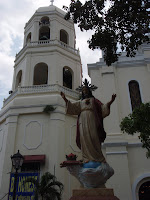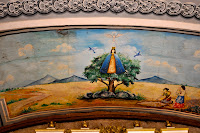The Visita Iglesia is a tradition of the Filipino people during holy week, wherein you have to visit seven churches. The group of friends decided to visit the different churches in Batangas. We are all amazed of the beautiful churches - cathedral and basilica of this province. Our first stop is the city of Lipa, the Lady of Mt. Carmel and St. Sebastian Cathedral, then San Jose, Batangas the St. Joseph Church, next is the Basilica of the Immaculate Conception, then we go to the town of Taal, we visited the St. Martin de Tours Church and our Lady of Casaysay and the last is the Caleruega Transfiguration Chapel.
1. Our Lady of Mt. Carmel Church



Amid the busy city of Lipa stands a church where solemnity and serenity can be best experienced. The convent of the contemplative order of Our Lady of Mt. Carmel. This church is well known among Batanguenos and perhaps to most Filipinos for this happens to be the site of the mysterious shower of rose petals decades ago.
Through the initiative of Bishop Alfredo Versoza and then auxilliary Bishop Alrfredo Ma. Obviar (who was the first father and chaplain of the monastery), the sisters from Carmel Manila left for their new monastery in Lipa on the same day Carmel Lipa was founded, which was the feast day of the Blessed Virgin Mary, Mediatrix of All Grace. This is primarily the reason why the Carmel has been associated with several forms of the Virgin Mary.
Carmel, as local folks refer to it, was founded on May 31, 1946, just a year after World War II left the town of Lipa in ruins (Lipa bounced back heavily and was made city in August 1947, after the Japanese killed more than 20,000 innocent Lipa natives, with more casualties resulting from massacres carried out by the Japanese when they were losing the war against the Americans in the ending years). Through the initiative of Bishop Alfredo Versoza and then auxilliary Bishop Alrfredo Ma. Obviar (who was the first father and chaplain of the monastery), the sisters from Carmel Manila left for their new monastery in Lipa on the same day Carmel Lipa was founded, which was the feast day of the Blessed Virgin Mary, Mediatrix of All Grace. This is primarily the reason why the Carmel has been associated with several forms of the Virgin Mary.
2. San Sebastian Cathedral Church






The cathedral of St. Sebastian is known simply as “Kadetral”. It stands tall right in the heart of Lipa City, among its business streets, young and bright students, great looking women, and its courteous and hospitals elders. Because its accessibility, the church itself is rarely empty, even when there’s no mass.
The feast of St. Sebastian is held at the 20th of January every year. In Lipa, it is usually a weeklong event with put-up shops lining the streets of the city, culminating in a concert or big gathering of different personalities. It was built in the Romanesque tradition with circular dome, massive walls and balconies. Its first construction was completed in 1865, but after the was it underwent massive constructions. The church has an architecture which used columns and arches in an ascending and descending order, creating the effect of a shadow and light play. The domes of the church and bell tower have elaborate moldings and arched stained-glass windows. The nave or body of the church is barrel-vaulted and now illuminated by modern chandeliers. It also features a winding stairway to the choir loft.
3. St Joseph Church in San Jose Batangas









The Magnificent church of St Joseph in San Jose, Batangas is 237 years old, established in 1765. The church was built by the Augustinian friar, Fr. Manuel Blanco in 1812. It has a large one-aisle interior and is remarkable for its restored main altar, geometrical decorations and flowery capitals on the columns. The church is a paragon of Baroque architecture in the Philippines and with elaborate carvings of local flora, combines this with the neo-classical lines of an adjacent convent.
4. Immaculate Conception Church Batangas







The Basilica de Immaculada Concepcion is considered to be one of the oldest Catholic churches in the province. Situated at the end of the main road of the city where most schools, offices and businesses are located, this church serves as a place for reflection for most, after a hard and busy day of school and work. Right in front of it is a spacious well maintained park. The surrounding of the church is lined with century old trees that a photo enthusiast had to walk around to find the best angle as the church is hidden behind lush greens. Even the park across the street is full of trees.
The Basilica's Historical Marker states the following story: The first church built in 1581 by Father Diego Mojica, Augustinian Pastor of Calapan, Mindoro was dedicated to the Immaculate Conception of our Mother as a Parish. In 1601, the stone foundation was placed for the second church on which the priests had it built from 1682-1721. The convent with artillery placements was built in 1693 as a defense against sea pirates. After 179 years, the church was demolished and rebuilding was led by Fr. Pedro Cuesta in 1851 and inaugurated in 1857. Dedicated as a Basilica Menor on February 13, 1948. Its centennial was celebrated in 1957.
The first church on the present site was built in 1581 by Father Diego Mojica, Augustinian Pastor of Calapan, Mindoro. In 1601, the stone foundation was placed for the second church on which the priests built from 1682-1721. The convent with artillery placements was built years later as a defense against sea pirates. After 179 years, the church was demolished. On the same year, the church was rebuilt through Fr. Pedro Cuesta’s endeavor. The church was then granted a Basilica status by Pope Pius XII. “Given in Rome, at St. Peters, with the seal of the Fisherman, on the 13th day of February in the year 1948, the tenth of our Pontificate -1948.” Since the church construction was offered to the Immaculate Concepcion, it was then called the Basilica de Immaculada Concepcion. Though the Basilica has been constructed, many years ago, it has maintained it’s well-built structure and exceptional make up. Vivid paintings on ceilings and walls are noticeable up to date.
5. St. Martin de Tours Church












It is identified as the largest Catholic church in Asia, the Basilica of St. Martin de Tours, which stand 96 meters tall and 45 meters wide on a plateau in the heart of the town of Taal. The church remains magnificent with its old but artistically beautiful make-up.
In 1570, Martin de Goiti and Juan de Salcedo, two Spanish generals explored the coast of Batangas on their way to Manila and came upon a Malay settlement at the mouth of Taal River. IN 1572, the town of Taal was founded and its convent and stone church were constructed later. It was first built by Father Diego Espina in 1575 in what is known as San Nicolas, which was historically a part of Balangon. It was destroyed when the volcano erupted in 1754. It was rebuilt at the present site in 1755, but was destroyed by an earthquake in 1849. The construction of the present church was started in 1856, according to the plans of architect, Lucian Oliver and later inaugurated in 1885.
The Augustinian Missionaries started construction in 1756, and it took a century for the church to achieve it present form. The façade resembles that of the St. Peter’s Basilica in Rome. Its tabernacle is made of silver, the one of its kind in the Philippines. The structure of this church is really magnificent.
6. Our Lady of Casaysay Church






The Church is a few minutes away from the main Basilicia of Taal, the Basilica of St. Martin de Tours. Not everyone know the place as there is also an altar dedicated to Our Lady of Casaysay inside the basilica. There is a “milagrosang balon” (miraculous spring) at the back of the church just across a stony path, you have to climbed a rugged rock to get to the grotto and an old arch under which lies the two miraculous spring.
We are expecting a big church similar to the different basilica we have visited, but it is a small church as just like of the image of Our Lady. The painting on the ceiling which is made in black and white is also beautiful.
Our Lady of Caysasay was the title given to Our Blessed Virgin Mary taken from the name of the Casaysay bird that flew around the image when it was found on the branch of a tree in the woods of Taal in the 1700s. Juan Maningkad, a fisherman found the statue in the Pansipit River in the year 1603. But Taal folks said strange phenomenon had occurred when the image "disappeared" from time to time but comes back again the next day. This puzzled the people, including the parish priest. During its disappearances, the statue goes back to the river where it was originally located. The image was then brought to the church of the barrio, but the same incident occurred. This strange happening was repeated a number of times prompting, Ms. Espiritu to report the matter to the parish priest. To investigate the mysterious coming and going of the image, the priest decided to have volunteers keep a vigil beside the turn. They sat and prayed, painstakingly waiting for the moment to happen. Then suddenly they saw with their eyes the glorious image going out from the turn and coming back again. The priest decided that the villagers should light candles and follow the image the next time it left from the turn. When the phenomenon again occurred the image led the people to Caysasay, the place it was originally found. The villagers concluded that it was the Lady's wish to stay in the river of Pansipit. A chapel was built in Labac. An orphanage was added to the sanctuary. The well and the sampaga tree from which the image was recovered was consecrated and marked by a stone arch bas-relief of the Virgin.
7. The Caleruega Transfiguration Chapel












The Caleruega Church is located in Nasugbu, Batangas a bit off Tagaytay City, which is a famous place for retreats and wedding ceremonies. The actual church is just small but the area surrounding is large with green hills and great landscapes in different direction. Its façade is a reproduction of the original chapel in Caleruega, Spain. Its hut-shaped roof is in remembrance of the temporary sheds that the apostles wanted to build for Jesus, Moses and Elijah during the transfiguration. The seal of Dominican Province of the Philippines is depicted in stained glass in the upper portion of the chapel’s façade.
This is a house of prayer wherein you can do a lot of activities like recollections, prayer and renewal workshops, youth camps, marriage and family encounter celebrations, leadership seminars environment activities and so much more. It is one of the most favorite churches for weddings, it is so in-demand that you need to book a date a year ahead.
Further, down the hill, there’s a hanging rope bridge connecting to a larger and orchard which is always flocked by families and tourist for an afternoon picnic. On a regular day, visitors are charged a minimal entrance fee of P20.00.



No comments:
Post a Comment